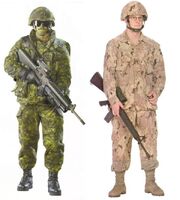CADPAT, short for Canadian Disruptive Pattern, is a series of camouflage patterns developed and fielded by the Canadian Armed Forces.
Overview[]

Woodland CADPAT
Canada's desire for a new soldier system dates back to November 1988 and closely follows efforts in many NATO countries. The first research effort, called Integrated Protective Clothing and Equipment (IPCE) Technology Demonstration was initiated in 1995 but then was cancelled, due to high systems cost and failure to meet the majority of the requirements. Ongoing operations in the mid 1990s led to the creation of the Clothe the Soldier (CTS) Project, which directly addressed the NATO soldier system capability areas of survivability and sustainability. The Canadian Disruptive Pattern was a part of ongoing research and implemented during the Clothe the Soldier Project (CTS). In development for the better part of a decade, the pattern comes in three varieties: temperate woodland (TW), arid region (AR), and winter/arctic (WA). The temperate woodland pattern became the standard issue for the Army in 2002, with the Air Force following suit in 2004. Uniforms and equipment in CADPAT material replaced the olive green material in use since the early 1960s.
Some civilian firms are licensed to sell clothing and accessories using CADPAT-like material (though not the same IR-defeating type used by the CF), as long as the patterns do not match official CF uniform and equipment patterns. These are commercially available from a wide variety of sources.
Variations[]
- Temperate woodland
CADPAT TW has four specific colours — light green, dark green, brown, and black — and was first introduced in 1996 on the helmet cover for the new CG634 helmet then coming into service. At the same time, the pattern was also introduced on a new soldier's individual camouflage net. The CADPAT TW uniform allows Canadian soldiers protection from observation by the naked eye and night vision devices.

Comparison of Temperate Woodland and Arid Regions CADPAT
- Arid regions
Concurrent with the trials of CADPAT TW, work was carried out to identify a uniform for operations in desert, near desert, and savannah environmental conditions. This three-colour pattern, known as CADPAT arid regions (AR), incorporates three different colours of brown. CADPAT AR also features two additional arm pockets and Velcro on the arms compared to the TW uniform. In light of the deployment of the Immediate Reaction Force to Afghanistan, the CADPAT AR project was expedited with the intent that it would be issued to soldiers in summer 2002.
- Winter/arctic
The winter/arctic pattern was introduced as an upgrade to the current monochrome winter whites to further enhance the Canadian soldier's camouflage capability by day and night. It includes near infra-red (NIR) technology.
- Urban
Defence Research and Development Canada based at CFB Suffield (DRDC-S) developed a new urban pattern for the Canadian Forces based on the three largest metropolitan areas of Canada: Toronto, Vancouver, and Montreal. This new pattern is known as the Canadian urban environment pattern (CUEPAT).